137 Search Results for teaching tips
March 2, 2017
by Carole Zangari -
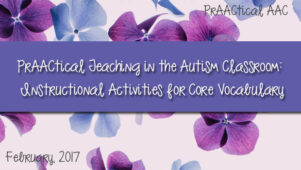
“But I don’t have just one student who needs AAC in my class – I have a bunch! How can I work AAC teaching into an already hectic day?” Teachers Amy Devin and Lauren Pawlowski are back with real-world suggestions for situations like these. Last year, they introduced us to Big Core, gave us tips for implementing it in the classroom, and explained how they integrate it into shared reading lessons and predictable chart writing activities. Today, they’re back with prAACtical information on how they provide explicit instruction on core vocabulary words. Amy and Lauren are public school teachers in Michigan who began teaching in resource rooms and moved to self‐contained ASD elementary classrooms in 2009. There was not much talk about core language when they started teaching and even less about incorporating into classroom lessons. AAC devices have changed a bit over the years, too. Initially, they worked with a 32-location core board on... [Read More...]
October 31, 2016
by Carole Zangari -
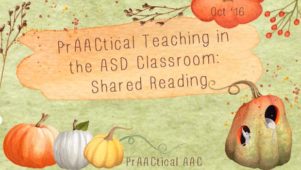
We are pleased to have a return visit from special educators Lauren Pawlowski and Amy Devin with ideas for supporting AAC learners in the classroom. Amy and Lauren, who work in the public school system in Michigan, taught in resource rooms for years and have been teaching in self‐contained ASD elementary classrooms since 2009. At that time, there were few classrooms who were integrating core language instruction, but they didn’t let that stop them. Currently, they use manual communication boards, large instructional core boards, and individual AAC devices with their students. They are passionate literacy teachers and, in today’s post, tell us about their approach to shared reading lessons. Their video is chock full of tips to help you make these lessons successful. Enjoy! Shared Reading: It’s Not What They Know, It’s What They THINK! Happy Fall AAC users and facilitators! This month we would like to share some of our tips for... [Read More...]
November 20, 2014
by Carole Zangari -
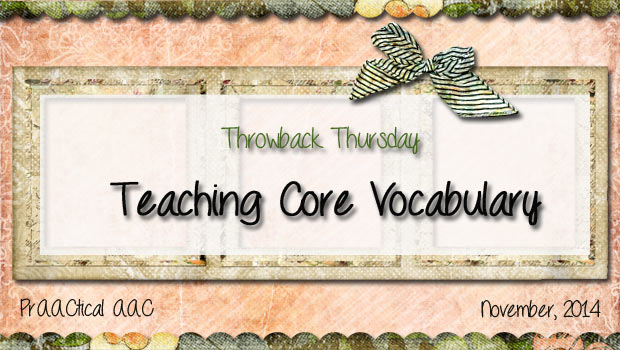
While I’m soaking up AAC knowledge at the ASHA Convention, here’s a post from the past. :::::::::::::::::::::::::::::::::::::::::::::::::::::::: Among the many changes that the AAC field has experienced in the last decade is the notion that core vocabulary is (or should be) an integral part of any AAC system. We grew to understand the limitations of AAC supports that consist primarily of nouns and descriptors, realizing that those kinds of communication displays restricted our clients to requesting and labeling. Our field realized the inadequacy of providing only prestored messages (e.g., limited the client’s ability to communicate anything novel, not flexible enough to meet most communication needs, etc.). In essence, we realized that without core vocabulary, we were imposing a ceiling on language development. We’re thrilled to see so many communication boards, books, SGDs, and AAC apps reflect this knowledge. Having tools with the appropriate vocabulary is a big step in the... [Read More...]
May 30, 2014
by Robin Parker -
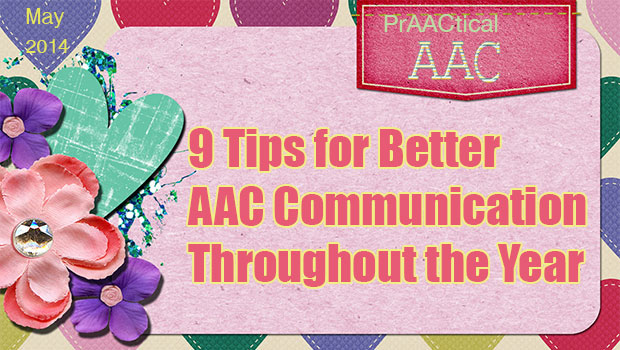
Although Better Hearing and Speech Month is ending, we want to continue best prAACtices in all teaching interactions throughout the year. Here are 9 AAC facilitator tips to help with this goal. Provide Aided Language Input (ALI)– ALI is modeling AAC style. Speak AAC to the AAC user. Use Scaffolding– Scaffolding is a verbal and visual strategy that has the facilitator build upon prior knowledge of the learner in order for the learner to integrate a new concept or skill. Model words and concepts to add information onto what the AAC user already knows and uses. Provide Expansions and Extensions– A form of modeling. Add a word to the spontaneous communication from the learner. The facilitator models a conceptual or grammatical word in the form of a model. Use Recasting– Recasts serve to add or correct information without obstructing the natural flow of communication. Recasting is another form of modelling. The... [Read More...]
April 24, 2014
by Robin Parker -

We love so many blogs, websites, and videos. Parents and professionals take their own time and effort (and often money) to share AAC strategies that have worked for them and their children and students. Here are just a few great ones that we use often when working with graduate students and other professionals to help demonstrate a variety of ways AAC strategies make a difference. Enjoy! Beach Trip (and on the Road) by Dana Nieder at Uncommon Sense Helping an AAC User Learn New Vocabulary by Deanne Shoyer at Small but Kinda Mighty AAC Tips at Kreeds World Complex Needs and Switches: It Could Be You! by Ian Bean at SENICT- Special Education Needs ICS How AAC and Assistive Tech Make Classrooms Better for All by Paula Kluth at Paula Kluth Toward Inclusive Classrooms and Communities
April 6, 2013
by Carole Zangari -
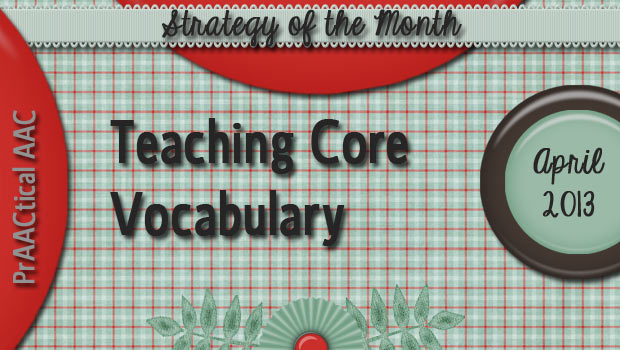
Among the many changes that the AAC field has experienced in the last decade is the notion that core vocabulary is (or should be) an integral part of any AAC system. We grew to understand the limitations of AAC supports that consist primarily of nouns and descriptors, realizing that those kinds of communication displays restricted our clients to requesting and labeling. Our field realized the inadequacy of providing only prestored messages (e.g., limited the client’s ability to communicate anything novel, not flexible enough to meet most communication needs, etc.). In essence, we realized that without core vocabulary, we were imposing a ceiling on language development. We’re thrilled to see so many communication boards, books, SGDs, and AAC apps reflect this knowledge. Having tools with the appropriate vocabulary is a big step in the right direction. But to really shatter the ceiling of language development, we have to be good at... [Read More...]
February 7, 2013
by Carole Zangari -
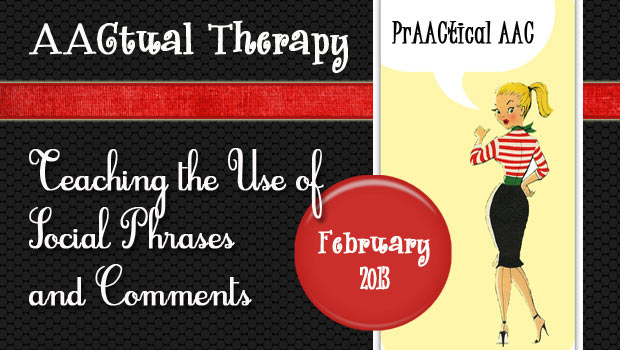
We are so happy to have Deanna Wagner back with more AACtual Therapy. In her previous post, Deanna talked about her work with AAC groups for adults. Today, she shares a lesson plan and some implementation ideas. As a veteran AAC interventionist, Deanna’s therapy plan has many wonderful features that undoubtedly contribute to the success her students experience. Lesson/therapy Session: Using Social Phrases/Comments Intended audience & type of AAC: All devices/AAC users should have access to social commenting. Our Class: Middle school, self-contained classroom. Group of 3 students, SLP leading activity, paraprofessional, and Teacher of Visually Impaired supporting Goal for Overall Lesson: Use word/icon combinations to express opinions or make social comments Specific Student Goals: Student #1 will combine 2 icons for social interjections – please, thank you, cool, awesome, yum, yuk, ok (ECO2 from PRC) Student #2 will functionally use new phrases to chat or indicate an opinion (Dynavox... [Read More...]
November 24, 2024
by Carole Zangari -
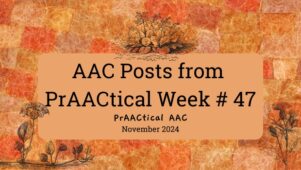
Happy Sunday, AAC friends, and a good Thanksgiving to those who celebrate that holiday this week. In the meantime, we’ve got some posts you may want to look through. Tuesday – AAC Link Up Wednesday – Video of the Week: Getting Ready for December School Year of Core Vocabulary Words Older Student Lessons Thursday – PrAACtically Thanksgiving: AAC-friendly Resources for Turkey Day Fun ::::::::::::::::::::::::::::::::::::::::::::::::::::::::::::::::::::::::::::::::::::::::::::::::::::::::::::::::::::::::::: Looking for a few more places to browse? Here are some selected posts on making and using visual supports. Free Resources for Making AAC and Visual Supports How I Do It – Using an App to Make AAC Materials and Visual Supports AAC Teaching Tips on Scaffolding and Visual Supports Designing and Using Visual Supports for Older Students 5 Visual Supports for the AAC Classroom Wishing a meaningful week to all of our readers!
January 18, 2024
by Carole Zangari -
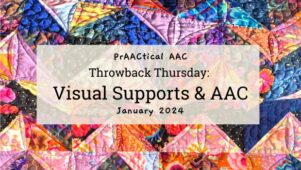
Visual supports are so flexible, easy to create and use, and have such a nice evidence base that it’s something we use in almost every AAC therapy or instructional session. In today’s Throwback Thursday, we’re revisiting a handful of our past posts on what they are, how to create them, and how they can be implemented. Enjoy! Video of the Week: Video Models & Visual Supports for AAC PrAACtically Visual: More Supports for Your Toolbox Visuals, Timers, & Zoom Addressing the Social, Communication, and Behavioral Needs of Secondary Students with ASD using Visual Supports AAC Teaching Tips on Scaffolding and Visual Supports Visual Supports for an AAC-friendly Easter and Passover 5 Visual Supports for Emotions and Feelings
September 16, 2023
by Carole Zangari -
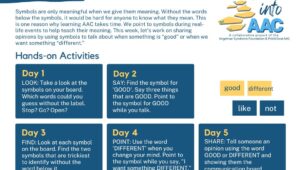
About This Week Welcome to Week 3 of your Stepping into AAC journey! This week will get us thinking about how words are symbolized, what kinds of words should be on AAC systems, and other foundational information. We will explore the following concepts this week: Why Use Symbols for AAC? Gain an understanding of symbolic communication and issues related to using picture symbols in AAC systems. Balancing Core and Fringe Vocabulary: Learn about different types of words that AAC learners need access to and the role of each. Navigating AAC: Build your knowledge of the logic in the design of communication boards, AAC apps, and speech-generating devices. AACtion Steps Week 3 AACtion Steps Signposts Link to References Gayl Porter & Linda Burkhart, 2010 – Limitations of Using a Representational Hierarchy Get the Handout Balancing Core & Fringe Get the Handout Navigating AAC- 3 Things to Know Travelog Week 3 Travelog... [Read More...]









